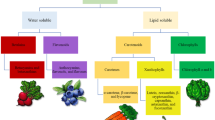Abstract
Near-infrared spectroscopy (NIR) was applied to the quantitative analysis of the concentration of alpha-mangostin (aM) in mangosteen pericarp powder (MP). The predicted results from the partial least squares chemometric method of various pretreatment data were compared to obtain the best calibration model. Two different types of containers (transparent capsules and glass vials) filled with the same samples were measured. For MP mixture in vials, the calibration model involving nine principal components (PC) could predict the amount of aM most accurately based on non-pretreatment spectral data. For MP mixture in capsules, the calibration model involving nine PC could predict the amount of aM most accurately based on first-derivative pretreatment spectra. The relationships of the calibration models for both samples had sufficiently linear plots. The standard error of cross-validation for the MP mixture in vials was lower and the R 2 values of validation were higher compared to the MP mixture in capsules. The equation for prediction of the concentration of aM in MP mixtures in vials is y = 0.9775x + 0.0425 with R 2 = 0.9950 and for those in capsules is y = 1.0264x + 0.0126 with R 2 = 0.9898. Both validation results indicated that the concentrations of aM in MP mixtures were predicted with sufficient accuracy and repeatability. NIR can be a useful tool for the quality control of herbal medicine in powder form without any sample preparation. The type and the shape of the container should be considered to obtain more accurate data.







Similar content being viewed by others
References
World Health Organization (2007) WHO guidelines on good manufacturing practices (GMP) for herbal medicines
Gowen AA, O’Donnell CP, Cullen PJ, Bell SEJ (2008) Recent applications of chemical imaging to pharmaceutical process monitoring and quality control. Eur J Pharm Biopharm 69:10–22
Reich G (2005) Near-infrared spectroscopy and imaging: basic principles and pharmaceutical applications. Adv Drug Deliv Rev 57:1109–1143
Herkert T, Prinz H, Kovar KA (2001) One hundred percent online identity check of pharmaceutical products by near-infrared spectroscopy on the packaging line. Eur J Pharm Biopharm 51:9–16
Otsuka M, Kato F, Matsuda Y, Ozaki Y (2003) Comparative determination of polymorphs of indomethacin in powders and tablets by chemometrical near-infrared spectroscopy and x-ray powder diffractometry. AAPS Pharm Sci Tech 4(2):Article 19
Blanco M, Coello J, Iturriaga H, Maspoch S, De La Pezuela C (1988) Near-infrared spectroscopy in the pharmaceutical industry. Analyst 123:135R–150R
Otsuka M (2004) Comparative particle size determination of phenacetin bulk powder by using Kubelka–Munk theory and principal component regression analysis based on near-infrared spectroscopy. Powder Technol 141:244–250
Otsuka M (2006) Chemoinformetrical evaluation of granule and tablet properties of pharmaceutical preparations by near-infrared spectroscopy. Chemom Intell Lab Syst 82:109–114
Mark H, Ritchie GE, Roller RW, Ciurczak EW, Tso C, MacDonald SA (2002) Validation of a near-infrared transmission spectroscopic procedure, part A: validation protocols. J Pharm Biomed Anal 28:251–260
Ritchie GE, Roller RW, Ciurczak EW, Mark H, Tso C, MacDonald SA (2002) Validation of a near-infrared transmission spectroscopic procedure. Part B: application to alternate content uniformity and release assay methods for pharmaceutical solid dosage forms. J Pharm Biomed Anal 29:159–171
Kreft K, Kozamernik B, Urleb U (1999) Qualitative determination of polyvinylpyrrolidone type by near-infrared spectrometry. Int J Pharm 177:1–6
Bennett GJ, Lee HH (1989) Xanthones from Guttiferae. Phytochemistry 28:967–998
Iinuma M, Tosa H, Tanaka T, Asai F, Kobayashi Y, Shimano R, Miyauchi K (1996) Antibacterial activity of xanthones from Guttiferaeous plants against methicillin-resistant Staphylococcus aureus. J Pharm Pharmacol 48:861–865
Keigo N, Norimichi N, Tsutomu A, Hideyuki Y (2002) Inhibition of cyclooxygenase and prostaglandin E2 synthesis by gamma-mangostin, a xanthone derivative in mangosteen, in C6 rat glioma cells. Biochem Pharmacol 63:173–179
Pothitirat W, Gritsanapan W (2008) Quantitative analysis of total mangostins in Garcinia mangostana fruit rind. J Health Res 22(4):161–166
Jefferson A, Stacey CL, Scheinmann F (1971) Gas liquid chromatography of naturally occurring xanthones and related derivatives. J Chromatogr A57:247–254
Ji X, Avula B, Khan IA (2007) Quantitative and qualitative determination of six xanthones in Garcinia mangostana L. by LC–PDA and LC–ESI–MS. J Pharm Biomed Anal 43:1270–1276
Walker EB (2007) HPLC analysis of selected xanthones in mangosteen fruit. J Sep Sci 30(9):1229–1234
Ministry of Health, Labour and Welfare (2006) Japanese Pharmacopoeia. Fifteenth edition, Tokyo
Jujun P, Pootakham K, Pongpaibul Y, Tharavichitkul P, Ampasavate C (2009) HPLC determination of mangostin and its application to storage stability study. CMU J Nat Sci 8(1):43–53
Osborne BG, Fearn T (1986) Near infrared spectroscopy in food analysis. Longman Scientific & Technical, UK
Acknowledgments
This research was supported by a grant from the Hitachi Scholarship Foundation. We would also thank Musashino University and Khon Kaen University for providing us with the chemicals and the apparatus used in this study, and Ms Pensiri Sirikumgorn for MP preparation.
Author information
Authors and Affiliations
Corresponding author
Rights and permissions
About this article
Cite this article
Peerapattana, J., Otsuka, K. & Otsuka, M. Application of NIR spectroscopy for the quality control of mangosteen pericarp powder: quantitative analysis of alpha-mangostin in mangosteen pericarp powder and capsule. J Nat Med 67, 452–459 (2013). https://doi.org/10.1007/s11418-012-0698-z
Received:
Accepted:
Published:
Issue Date:
DOI: https://doi.org/10.1007/s11418-012-0698-z




